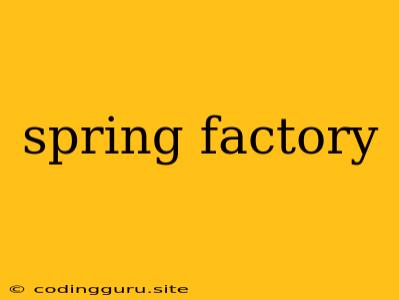Demystifying the Spring Factory: Your Guide to Efficient Bean Creation
The Spring Framework is renowned for its powerful dependency injection mechanism, which simplifies application development by managing object creation and dependencies. At the heart of this system lies the Spring Factory, a crucial component responsible for instantiating and configuring the beans that form the backbone of your application.
What is a Spring Factory?
In essence, the Spring Factory is the central hub for managing beans within your Spring application. It acts like a sophisticated "bean factory," orchestrating the creation, configuration, and lifecycle of all your beans. Think of it as a centralized repository where you can easily access and manage all the components that make up your application.
How Does the Spring Factory Work?
The Spring Factory relies on a combination of XML configuration files, annotations, and Java code to achieve its magic. When your application starts, the Spring Factory analyzes your configuration and creates a "bean definition" for each object you want to manage. This bean definition contains all the necessary information about the bean, including its class, constructor parameters, and properties.
The Spring Factory then uses this information to instantiate the bean, injecting any required dependencies based on your configuration. This process ensures that all your beans are properly configured and ready to be used within your application.
Why is the Spring Factory Important?
The Spring Factory plays a pivotal role in simplifying your application's architecture. Here's why it's so essential:
- Dependency Injection: The Spring Factory facilitates dependency injection, automatically resolving dependencies between your beans. This eliminates the need for manual wiring, leading to cleaner and more maintainable code.
- Centralized Management: The Spring Factory acts as a central hub for all your beans, providing a unified mechanism for accessing and managing them. This simplifies the process of configuring and working with your application's components.
- Lifecycle Management: The Spring Factory also handles the lifecycle of your beans, managing their initialization, destruction, and any necessary post-processing. This ensures that your beans are properly managed throughout their lifespan.
How to Leverage the Spring Factory in Your Applications
Here are some practical tips to effectively utilize the Spring Factory:
- Configuration: Define your beans using XML configuration files or annotations. This tells the Spring Factory how to create and manage your beans.
- Dependency Injection: Inject dependencies into your beans using constructor injection or field injection. The Spring Factory will automatically resolve these dependencies based on your configuration.
- Custom Beans: Define your own custom beans that encapsulate specific functionality. The Spring Factory will handle their creation and management.
Example: Defining a Bean with the Spring Factory
@Component
public class MyService {
@Autowired
private MyRepository myRepository;
// ...
}
@Repository
public class MyRepository {
// ...
}
In this example, the @Component annotation tells the Spring Factory to create a bean for MyService. The @Autowired annotation specifies that the MyRepository bean should be injected as a dependency into MyService. The @Repository annotation signifies that MyRepository is a data access layer component.
Understanding Common Spring Factory Concepts
- Bean Definition: A representation of a bean, containing its class, constructor parameters, and properties.
- BeanFactory: An interface that provides methods for creating and managing beans.
- ApplicationContext: A superset of
BeanFactorythat adds features like event publishing and resource loading. - Bean Scope: Controls the lifetime and sharing of beans within your application. Common scopes include singleton (one instance shared across the application), prototype (a new instance created each time a bean is requested), and request (a new instance created for each web request).
Conclusion
The Spring Factory is a cornerstone of the Spring Framework, enabling efficient bean management and simplifying dependency injection. By understanding its functionality and leveraging its features, you can create cleaner, more maintainable, and highly scalable applications. As you delve deeper into Spring development, mastering the Spring Factory becomes crucial for maximizing your application's potential.
